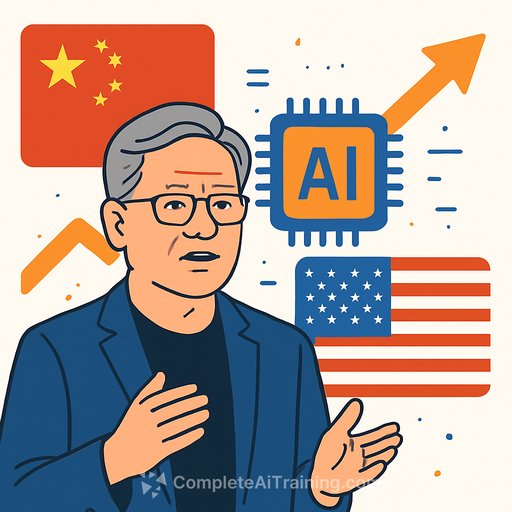China May Win the AI Race: What Jensen Huang's Message Means for Your Strategy
"China will win the artificial intelligence race," said Nvidia CEO Jensen Huang at a November summit. Hours later, he clarified: China is "nanoseconds behind" the U.S., and America must "race ahead" and attract global developers.
The message landed like a board-level alert. Lower energy costs, lighter regulation, and state-backed scaling give Beijing momentum. The U.S. has the talent and the companies-but also more friction, more rules, and a growing risk of complacency.
AI Is Now Geopolitics
This contest sets the standards for business, security, and social norms. The winner writes the rules. Washington is pushing ethical guardrails for defense AI while trying to keep U.S. tech lead intact.
See the U.S. stance on ethics in defense AI for context: DoD AI ethical principles.
Two Operating Models
China runs a coordinated, state-directed system where capital, energy, and policy align behind AI deployment. The U.S. runs a decentralized, market-driven model where private firms and open science lead. That produces top-tier innovation-and coordination gaps under pressure.
Background on the broader tech rivalry: Atlantic Council analysis.
Defense: Autonomy Meets Deterrence
Ukraine showed how cheap drones and smart systems can tilt the field. In 2023, the Pentagon launched Replicator to field swarms of autonomous air and maritime systems to offset China's scale and deter conflict, including scenarios around Taiwan.
China is pushing hard too-UAVs, underwater drones, targeting systems, and the PLA's plan to "intellectualize" by 2030. In Washington, advanced chips are treated as strategic assets-not components.
Inside Nvidia's Calculus
The public messaging matters. Huang's line amplifies urgency: invest in compute, energy, data centers, and defense AI now. Nvidia doesn't just sell GPUs-it owns a platform (CUDA, libraries, deployment stacks) that pulls the ecosystem with it.
There are weak points: reliance on Taiwan manufacturing (TSMC), U.S. export limits, and hyperscalers building their own silicon. If the market tilts from giant centralized models to swarms of smaller edge models (drones, vehicles, battlefield systems), Nvidia's dominance could thin out.
And a necessary correction: what we call AI today are statistical models. They predict the next token, target, or action. Think of a ballistic calculator-it computes according to inputs and rules; it doesn't "understand" the world. Useful, yes. Sentient, no. Control over these prediction systems still delivers military, economic, and political leverage.
Controls, Chips, and Unintended Consequences
U.S. policy tightened. In late 2025, Washington blocked shipments of Nvidia's latest Blackwell GPUs to China, while allies received exceptions. Beijing moved in parallel, restricting foreign chips in key state systems.
Result: Nvidia's China revenue dropped near zero-hurting U.S. reinvestment capacity. The bigger risk, as industry leaders warn, is pushing China to accelerate indigenous chips, local ecosystems, and import substitution. Short-term slowdown, long-term self-sufficiency.
Who's Ahead-and For How Long?
America holds key advantages: elite startups, research universities, open talent flows, and capital. China counters with scale: data access, coordinated execution, and political will to lead by 2030. Both sides are pressing the accelerator out of ambition and fear of lagging.
There may be no clear finish line. AI is a moving target. The practical question for executives: how do you hedge, place bets, and build resiliency while this plays out?
Executive Playbook: What to Do in the Next 12 Months
- Compute strategy: Secure multi-vendor access (Nvidia, AMD, cloud TPUs, custom ASICs). Pre-negotiate capacity and timelines. Model costs under tighter export regimes.
- Energy advantage: Lock power via PPAs or colocate with low-cost energy to cut training and inference costs at scale.
- Supply chain risk: Hedge Taiwan exposure. Map critical dependencies (foundry, packaging, optics, networking) and design alternates.
- Central vs edge: Pilot edge AI for latency-critical use cases (industrial vision, autonomy, field ops). Optimize model size and on-device acceleration.
- Data moats: Build proprietary datasets with clear rights. Invest in labeling, synthetic data pipelines, and feedback loops that improve accuracy.
- Model portfolio: Blend foundation models with task-specific smaller models. Reduce inference cost while keeping accuracy for core workflows.
- Talent and access: Hire globally. Create remote hubs near key universities. Sponsor visas where feasible. Partner with external research labs.
- Compliance by design: Bake export controls, model risk management, and auditability into your MLOps stack. Keep a clean paper trail.
- Dual-use posture: If your tech has defense relevance, establish guardrails, buyers' checks, and government liaisons early.
- Standards and alliances: Join working groups that set safety, testing, and evaluation norms. Influence the rules you will operate under.
- Scenario planning: Run quarterly stress tests for chip shortages, model access loss, or sudden policy shifts. Pre-plan cost and capacity rebalancing.
- Capex vs Opex: Decide where to own vs rent compute. Tie decisions to unit economics, latency needs, and data sensitivity.
Practical Next Step
If you're aligning teams around AI roles and skills, explore curated learning paths by function: AI courses by job. Build capability where value will be realized.
Bottom Line
Huang's message isn't surrender-it's a clock. The U.S. can win by moving faster, attracting talent, and scaling smarter. China will press scale and integration. Your edge comes from superior execution: secure compute, cheaper energy, proprietary data, and a resilient model portfolio.
Make decisions that compound. Everything else is noise.
Your membership also unlocks:






